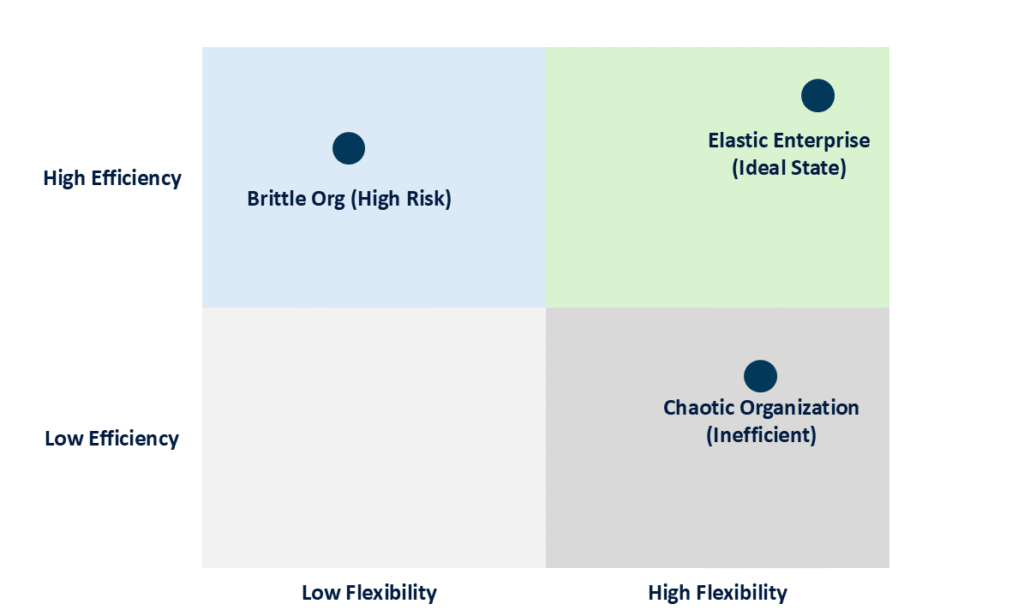In today’s economic climate, volatility is the only constant. Market disruptions, technological shifts, and sudden changes in global demand are no longer rare events; they are the rhythm of modern business. Organizations built for the stability of the past with rigid structures, fixed costs, and slow decision-making are dangerously brittle. They crack under pressure, whether from a sudden growth opportunity or an unforeseen contraction.
The defining trait of a future-ready organization is no longer mere size or brand strength, it is elasticity. An elastic enterprise can scale its resources, reshape its teams, and reallocate capital with speed and precision, all without breaking its core cultural or operational backbone. It is engineered not for a single state of being, but for dynamic adaptation.
This isn’t about survival; it’s about competitive advantage. This article outlines the strategic blueprint for building organizational elasticity.
The Case for Elasticity: Beyond Boom and Bust
The financial and strategic imperative for elasticity is clear. Traditional models are fraught with risk:
-
-
- Rigid cost structures are a primary killer in downturns. Our research found that companies that master flexibility during recessions grow at nearly triple the rate of their peers during the recovery.
- Talent agility is critical. The most “liquid” workforce is one that can fluidly adapt skills to new contexts which leads to drive a 15% increase in profitability for organizations that master it.
-
The goal is to replace brittleness with resilience, creating an organization that can withstand shock and capitalize on opportunity with equal prowess.
The Blueprint: Designing the Elastic Core
Elasticity is not achieved by accident. It is the product of intentional design across four key dimensions:
1. Structural Elasticity: The Module-Based Organization
Forget monolithic departments. The elastic enterprise is built around a core-periphery model.
-
-
- The Core: A small, permanent nucleus of essential employees defines the culture, sets strategy, and manages key relationships. This group provides stability.
- The Periphery: A dynamic ecosystem of modules – internal cross-functional teams, external partners, freelancers, and outsourced functions – that can be rapidly assembled, reconfigured, or disbanded based on current needs. This ecosystem provides flexibility.
-
This modular design allows you to scale specific capabilities (e.g., digital marketing, software development) up or down without the trauma of large-scale hiring or layoffs that affect the entire company.
2. Financial Elasticity: From Fixed to Variable Costs
Elasticity requires a fundamental rethink of the cost structure. The objective is to shift as many costs as possible from fixed to variable.
-
-
- Leverage the “As-a-Service” Economy: Utilize SaaS (Software-as-a-Service), IaaS (Infrastructure-as-a-Service), and other cloud-based offerings to convert capital expenditures into operational expenditures that scale with usage.
- Outcome-Based Partnerships: Move away from rigid, long-term contracts with vendors. Instead, forge partnerships with payment structures tied to specific outcomes, deliverables, or key performance indicators (KPIs). This aligns cost directly with value.
-
3. Workforce Elasticity: Building a Dynamic Talent Ecosystem
The future of work is a blend of full-time employees and a curated network of on-demand talent.
-
-
- Invest in a “Skills Inventory”: Use people analytics to map the skills, capabilities, and aspirations of your entire workforce – both internal and external. This allows you to quickly deploy the right talent to the right project.
- Embrace “Open Talent” Platforms: Tap into curated marketplaces like Topcoder, Toptal, and Upwork for specialized skills on a project basis. This allows you to inject world-class expertise into your organization without adding headcount.
- Focus on Internal Mobility: Encourage and facilitate lateral moves and project-based work within the company. This retains institutional knowledge and allows you to reskill and redeploy talent internally before looking outside.
-
4. Technological Elasticity: The API-Led Digital Foundation
Your technology stack must be as agile as your organization. Elasticity is impossible on a foundation of legacy, monolithic systems.
-
-
- Microservices Architecture: Break down large applications into smaller, independent services connected by APIs. This allows teams to develop, deploy, and scale specific functionalities without disrupting the entire system.
- Cloud-Native Infrastructure: Leverage the auto-scaling capabilities of cloud providers (AWS, Azure, Google Cloud). Your computing power, data storage, and application performance can automatically expand and contract to meet real-time demand, optimizing both performance and cost.
-
The Result: A Quantifiable Strategic Advantage
The impact of building an elastic organization is measurable across key performance indicators, most notably in its ability to manage through volatility.

Organizational Resilience Index: Performance Through Volatility
As the graph illustrates, while traditional “Brittle Orgs” may achieve high efficiency in stable times, they fail during volatility. “Chaotic Orgs” are flexible but inefficient. The Elastic Enterprise occupies the ideal quadrant, mastering the balance of both high flexibility and high efficiency, allowing it to thrive amidst uncertainty.
Your First Step: Conduct an Elasticity Audit
Transforming into an elastic enterprise is a journey. Begin by assessing your current state:
-
-
- Structural: What percentage of your work is done by teams that are reconfigured less than once a year?
- Financial: What is your ratio of fixed to variable costs? Can you tie more vendor payments to outcomes?
- Workforce: Do you have a real-time view of the skills available across your entire talent ecosystem (employees, contractors, partners)?
- Technology: Is your IT infrastructure capable of scaling up or down automatically based on demand?
-
The goal is to build an organization that sees change not as a threat, but as its natural environment. By designing for elasticity, you build a company that doesn’t just survive the future but shapes it.
Is your organization built to bend, not break? Contact our Organization Strategy consultants for a comprehensive Elasticity Assessment and build a resilient, adaptive, and future-proof operation.



